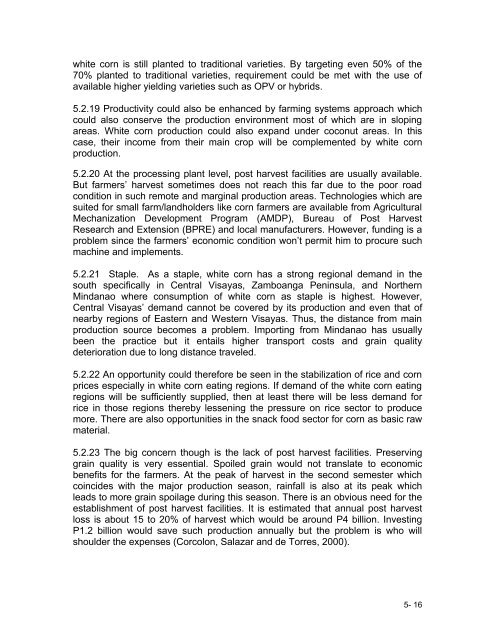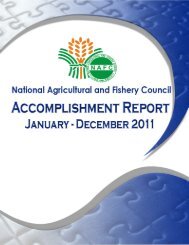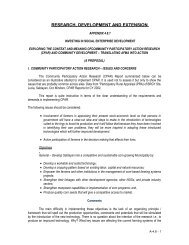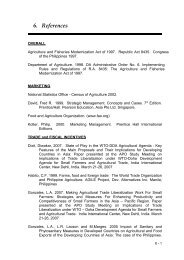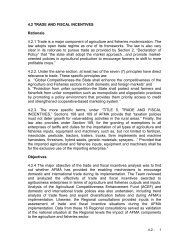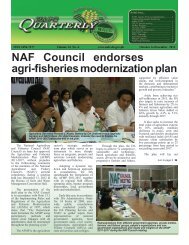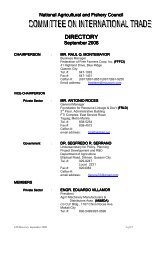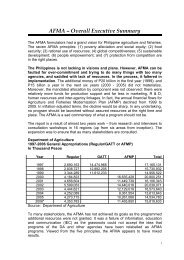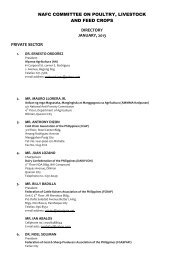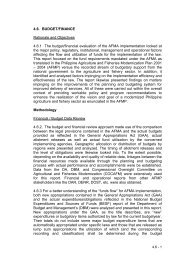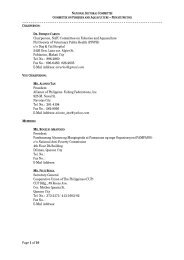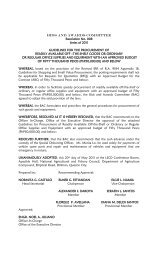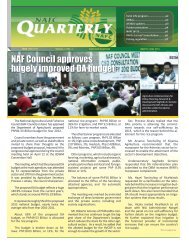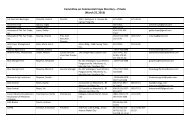5. Key Commodity Performance - National Agricultural and Fishery ...
5. Key Commodity Performance - National Agricultural and Fishery ...
5. Key Commodity Performance - National Agricultural and Fishery ...
Create successful ePaper yourself
Turn your PDF publications into a flip-book with our unique Google optimized e-Paper software.
white corn is still planted to traditional varieties. By targeting even 50% of the<br />
70% planted to traditional varieties, requirement could be met with the use of<br />
available higher yielding varieties such as OPV or hybrids.<br />
<strong>5.</strong>2.19 Productivity could also be enhanced by farming systems approach which<br />
could also conserve the production environment most of which are in sloping<br />
areas. White corn production could also exp<strong>and</strong> under coconut areas. In this<br />
case, their income from their main crop will be complemented by white corn<br />
production.<br />
<strong>5.</strong>2.20 At the processing plant level, post harvest facilities are usually available.<br />
But farmers’ harvest sometimes does not reach this far due to the poor road<br />
condition in such remote <strong>and</strong> marginal production areas. Technologies which are<br />
suited for small farm/l<strong>and</strong>holders like corn farmers are available from <strong>Agricultural</strong><br />
Mechanization Development Program (AMDP), Bureau of Post Harvest<br />
Research <strong>and</strong> Extension (BPRE) <strong>and</strong> local manufacturers. However, funding is a<br />
problem since the farmers’ economic condition won’t permit him to procure such<br />
machine <strong>and</strong> implements.<br />
<strong>5.</strong>2.21 Staple. As a staple, white corn has a strong regional dem<strong>and</strong> in the<br />
south specifically in Central Visayas, Zamboanga Peninsula, <strong>and</strong> Northern<br />
Mindanao where consumption of white corn as staple is highest. However,<br />
Central Visayas’ dem<strong>and</strong> cannot be covered by its production <strong>and</strong> even that of<br />
nearby regions of Eastern <strong>and</strong> Western Visayas. Thus, the distance from main<br />
production source becomes a problem. Importing from Mindanao has usually<br />
been the practice but it entails higher transport costs <strong>and</strong> grain quality<br />
deterioration due to long distance traveled.<br />
<strong>5.</strong>2.22 An opportunity could therefore be seen in the stabilization of rice <strong>and</strong> corn<br />
prices especially in white corn eating regions. If dem<strong>and</strong> of the white corn eating<br />
regions will be sufficiently supplied, then at least there will be less dem<strong>and</strong> for<br />
rice in those regions thereby lessening the pressure on rice sector to produce<br />
more. There are also opportunities in the snack food sector for corn as basic raw<br />
material.<br />
<strong>5.</strong>2.23 The big concern though is the lack of post harvest facilities. Preserving<br />
grain quality is very essential. Spoiled grain would not translate to economic<br />
benefits for the farmers. At the peak of harvest in the second semester which<br />
coincides with the major production season, rainfall is also at its peak which<br />
leads to more grain spoilage during this season. There is an obvious need for the<br />
establishment of post harvest facilities. It is estimated that annual post harvest<br />
loss is about 15 to 20% of harvest which would be around P4 billion. Investing<br />
P1.2 billion would save such production annually but the problem is who will<br />
shoulder the expenses (Corcolon, Salazar <strong>and</strong> de Torres, 2000).<br />
5- 16


